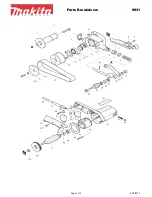
POLISHER
EN
7
c)
Prevent unintentional starting. Ensure the switch is in the off- position before connecting to power source and/or battery
pack, picking up or carrying the tool. Carrying power tools with your finger on the switch or energising power tools that
have the switch on invites accidents.
d)
Remove any adjusting key or wrench before turning the power tool on. A wrench or a key left attached to a rotating part of
the power tool may result in personal injury.
e)
Do not overreach. Keep proper footing and balance at all times. This enables better control of the power tool in unexpected
situations.
f)
Dress properly. Do not wear loose clothing or jewellery. Keep your hair, clothing and gloves away from moving parts.
Loose clothes, jewellery or long hair can be caught in moving parts.
g)
If devices are provided for the connection of dust extraction and collection facilities, ensure these are connected and
properly used. Use of dust collection can reduce dust-related hazards.
4)
POWER TOOL USE AND CARE
a)
Do not force the power tool. Use the correct power tool for your application. The correct power tool will do the job better
and safer at the rate for which it was designed.
b)
Do not use the power tool if the switch does not turn it on and off. Any power tool that cannot be controlled with the
switch is dangerous and must be repaired.
c)
Disconnect the plug from the power source and/or the battery pack from the power tool before making any adjustments,
changing accessories, or storing power tools. Such preventive safety measures reduce the risk of starting the power tool
accidentally.
d)
Store idle power tools out of the reach of children and do not allow persons unfamiliar with the power tool or these
instructions to operate the power tool. Power tools are dangerous in the hands of untrained users.
e)
Maintain power tools. Check for misalignment or binding of moving parts, breakage of parts and any other condition that
may affect the power tool’s operation. If damaged, have the power tool repaired before use. Many accidents are caused by
poorly maintained power tools.
f)
Keep cutting tools sharp and clean. Properly maintained cutting tools with sharp cutting edges are less likely to bind and are
easier to control.
g)
Use the power tool, accessories and tool bits etc. in accordance with these instructions, taking into account the working
conditions and the work to be performed. Use of the power tool for operations different from those intended could result in
a hazardous situation.
5)
SERVICE
a)
Have your power tool serviced by a qualified repair person using only identical replacement parts. This will ensure that the
safety of the power tool is maintained.
8.12.1.102
Additional safety instructions for all operations Kickback and Related Warnings
Kickback is a sudden reaction to a pinched or snagged rotating wheel, backing pad, brush or any other accessory.
Pinching or snagging causes rapid stalling of the rotating accessory which in turn causes the uncontrolled tool to be
forced in the direction opposite of the accessory’s rotation at the point of the binding. For example, if an abrasive wheel is
snagged or pinched by the workpiece, the edge of the wheel that is entering into the pinch point can dig into the surface of
the material causing the wheel to climb out or kick out. The wheel may either jump toward or away from the operator,
depending on direction of the wheel’s movement at the point of pinching. Abrasive wheels may also break under these
conditions.
Kickback is the result of tool misuse and/or incorrect operating procedures or conditions and can be avoided by taking
proper precautions as given below.
a)
Maintain a firm grip on the tool and position your body and arm to allow you to resist kickback forces. Always use
auxiliary handle, if provided, for maximum control over kickback or torque reaction during start-up. The operator can
control torque reactions or kickback forces, if proper precautions are taken.
b)
Never place your hand near the rotating accessory. Accessory may kickback over your hand.
c)
Do not position your body in the area where tool will move if kickback occurs. Kickback will propel the tool in direction
opposite to the wheel’s movement at the point of snagging.
d)
Use special care when working corners, sharp edges etc. Avoid bouncing and snagging the accessory. Corners, sharp
edges or bouncing have a tendency to snag the rotating accessory and cause loss of control or kickback.
e)
Do not attach a saw chain woodcarving blade or toothed saw blade. Such blades create frequent kickback and loss of
control.
CORRECT USAGE
-
This tool is designed to be used as a polisher. Read all the warnings, instructions, indications provided on drawings
and specifications supplied with this tool
. Failure to comply with all the instructions provided below may cause electrical
shocks, fire and/or serious injuries.
-
This tool is not intended to be used for smoothing, metal brushing and cutting operations
. The use of this tool for
unintended applications may cause hazards and injuries to people.
Summary of Contents for RP207183-R
Page 1: ...1 DE BETRIEBSANLEITUNG 2 5 EN USER S MANUAL 6 9 RU 10 13...
Page 10: ...RU 10 RP207183 R II II 230 50 60 5 3 A 1100 600 3000 180 M14 2 4 1 2 2 1 4 3 5 5...
Page 11: ...RU 11 3 4 5 8 12 1 102...
Page 12: ...RU 12 3 5 1...
Page 13: ...RU 13 180 4 2 4 4 2 5 1 WEEE 2002 96 CE WEEE 2003 108 CE...































